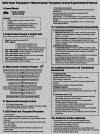Exploring mitochondrial health and transplantation strategies in DCD heart transplantation: a systematic review
- PMID: 40660219
- PMCID: PMC12257661
- DOI: 10.1186/s12967-025-06805-8
Exploring mitochondrial health and transplantation strategies in DCD heart transplantation: a systematic review
Abstract
This review explores the significant potential of mitochondrial transplantation (MT) in enhancing outcomes for DCD heart transplantation, particularly in mitigating ischemia-reperfusion injury (IRI). MT restores mitochondrial function and ATP production, thereby improving myocardial contractility and counteracting the energy depletion and oxidative stress that jeopardize the viability of DCD grafts. Furthermore, the synergistic application of MT with extracorporeal perfusion significantly enhances graft viability by reducing metabolic waste accumulation and modulating the inflammatory response during prolonged preservation. Studies show that MT decreases reactive oxygen species (ROS) levels, enhances antioxidant enzyme activity, and regulates immune activation, ultimately improving graft survival. Notably, MT has shown promising results in maintaining heart function during extended perfusion, delaying functional loss due to energy depletion. Despite encouraging preclinical findings, additional clinical validation is required, particularly in DCD heart transplantation, to confirm its potential in improving long-term graft function and expanding the donor pool in high-risk scenarios.
Keywords: Donation after circulation death; Heart transplantation; Ischemic reperfusion injury; Mitochondrial; Mitochondrial transplantation.
© 2025. The Author(s).
Conflict of interest statement
Declarations. Ethics approval and consent to participate: Not applicable. Consent for publication: Not applicable. Competing interests: The authors of this manuscript have no conflicts of interest to disclose.
Figures




Similar articles
-
Normothermic and hypothermic machine perfusion preservation versus static cold storage for deceased donor kidney transplantation.Cochrane Database Syst Rev. 2024 Jul 9;7(7):CD011671. doi: 10.1002/14651858.CD011671.pub3. Cochrane Database Syst Rev. 2024. PMID: 38979743 Free PMC article.
-
Mitochondrial injury during normothermic regional perfusion (NRP) and hypothermic oxygenated perfusion (HOPE) in a rodent model of DCD liver transplantation.EBioMedicine. 2023 Dec;98:104861. doi: 10.1016/j.ebiom.2023.104861. Epub 2023 Nov 3. EBioMedicine. 2023. PMID: 37924707 Free PMC article.
-
Regional perfusion by extracorporeal membrane oxygenation of abdominal organs from donors after circulatory death: a systematic review.Liver Transpl. 2013 Dec;19(12):1292-303. doi: 10.1002/lt.23771. Liver Transpl. 2013. PMID: 24136827
-
Advancements in Donation after Circulatory Death Heart Procurement and Preservation: A Comprehensive Review of Recent Innovations.Surg Technol Int. 2024 Jul 15;44:230-234. doi: 10.52198/24.STI.44.CV1801. Surg Technol Int. 2024. PMID: 39083443
-
Association of perfusate cytokine concentrations during liver graft ex situ normothermic perfusion to donor type and postoperative outcomes.Liver Transpl. 2025 Jul 1;31(7):877-889. doi: 10.1097/LVT.0000000000000583. Epub 2025 Feb 11. Liver Transpl. 2025. PMID: 39927817
References
-
- Page A, Messer S, Berman M, Kaul P, Pavlushkov E, Parameshwar J, et al. Heart transplantation from donation after circulatory determined death: the Royal Papworth experience. J Heart Lung Transplantation. 2020;39(4):S134. - PubMed
Publication types
MeSH terms
Substances
Grants and funding
LinkOut - more resources
Full Text Sources
Medical

